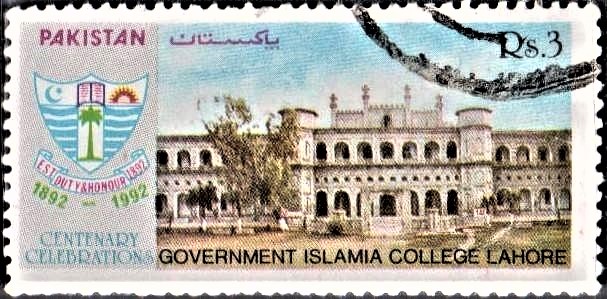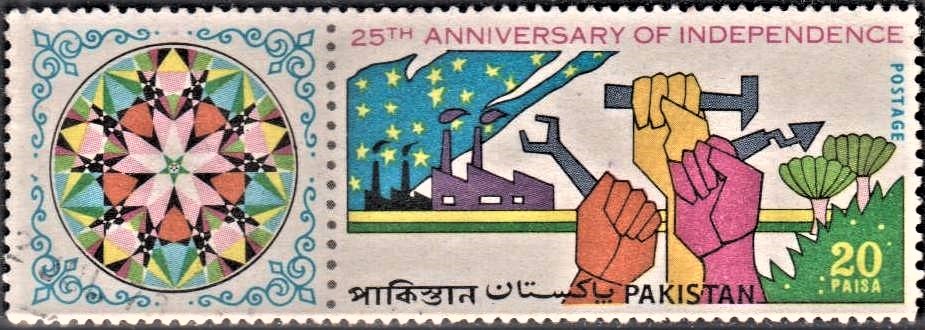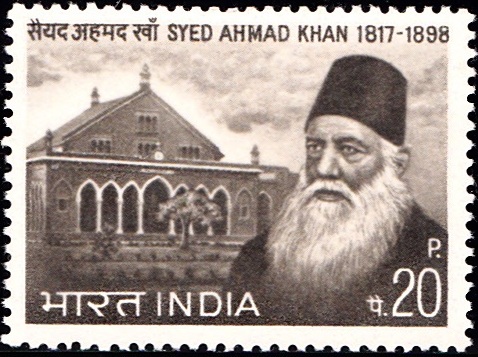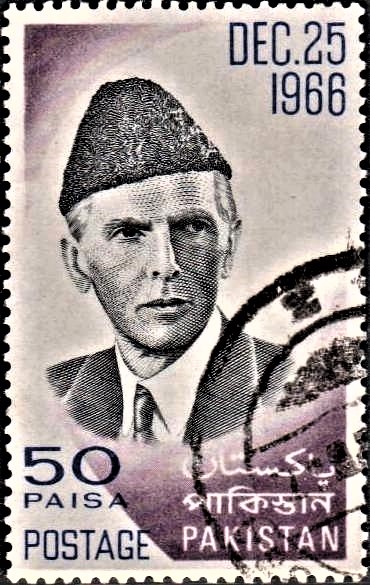
Government Islamia College, Lahore
A commemorative postage stamp on the Government Islamia College Lahore – Centenary Celebrations 1992 (1892–1992) :
 Issued by Pakistan
Issued by Pakistan
Issued on Nov 1, 1992
Issued for : To commemorate the occasion Pakistan Post is issuing a stamp of Rs. 3/- denomination on November 1, 1992.
Designer : Ilyas Ahmed Jillani (PSPC)
Type : Stamp, Postal Used
Denomination : Rs. 3/-
Colour : Multi colour
Size of Stamp : 50.9 x 24.5 mm
Size of Print : 47 x 21.5 mm
Perforation : 13C
Paper : 102 gsm dual purpose coated PVA gum
Quantity : Two million
Number of stamps in a sheet : 32 (4 x 8 rows)
Process of Printing : Litho Offset
Printers : Pakistan Security Printing Corporation
About :
- Sir Syed Ahmad Khan’s enthusiasm to improve the living conditions of the down cast Muslim Community of the Sub-continent remained high and fervent even after the establishment of a College, because he could fore-see that Aligarh Institution was not strong enough to cater to the needs of the Muslim community of British India. He believed that it was extremely necessary that the Muslims of India should be provided with a plat-form where they could assemble and evolve a common ground of understanding and line of action. In order to accomplish his goals, Sir Syed Ahmad Khan under-took extensive tours of the country and it was quite encouraging and inspiring that his movement received a tremendous, favourable response in the Punjab.
- Inspired by the pioneering work done by Sir Syed, people who favoured and supported his philosophy and ambitious plans resolved to embark upon founding an organization that was named, Anjuman-e-Himayat-e-Islam. Prominent among the founders of the Anjuman were Khalifa Hamid–ud–Din, Haji Mir Shams–ud–Din, Haji Mian Karim Baksh and Dr. Muhammad Din Nazir, Sir Syed Ahmad Khan participated in one of the meetings of the Anjman. In his address, he said “If Aligarh is my right eye, Lahore is my left eye, if Aligarh is my left hand, Lahore is my right hand”. This statement of Sir Syed Ahmad Khan provided an impetus to the stalwarts of the Anjuman and its supporters and the result was that in 1891, the General Council of the Anjuman adopted a resolution for the establishment of a College in Lahore.
- In the year 1892, Islamia College Lahore was housed in a modest, two-room, portion of Islamia High School Sheranwala Gate, Lahore. One room was reserved for the first year class and the other was jointly shared by the Principal, the teaching staff and the College Clerk. The Cardinal aim and object of this academic exercise was to facilitate the sons of poor Muslim parents to have access to the oriental as well as western education. The College remained to Intermediate Classes for approximately eight years.
- In the year 1900, the College was upgraded and the Degree classes were introduced. In 1904 the College was shifted to a private building on the Railway Road, Lahore. In 1905 the College had another milestone of progress when arrangements were made for teaching Post Graduate Classes in Arabic.
- The foundation stone of the College was laid in 1907 by Late Sardar Habibullah Khan, the King of Afghanistan. It was in 1912 that the classes were housed for the first time in the College at its present site, which covers an area of about Ten Acres. In the centre stands the majestic and magnificent Habibla Hall, flanked on both sides by class rooms, Science Block and Science Laboratories.
- The College was bifurcated in 1958. The Intermediate Classes were retained on the campus and the Degree and Post Graduate classes were shifted to a building known as D.A.V. College, Lahore. The institution housed there came to be Islamia College Civil Lines, Lahore. The College even today enjoys the reminiscences of its Principals and teachers such as Mr. Henry Martin, Allama Abdullah Yousaf Ali, Mr. P. E. Richards, Mr. Hamid Ahmad Khan, Mr. A. M. Ghani and Syed Abdul Qadir. The greatness of an institution manifested neither by its grand architectural design nor by the eminence of its teachers and the taught, but by its contribution to the religious, moral, intellectual, cultural and transcendental heritage which makes it the custodian of the eternal law and dimensions set forth in the Holy Quran. It is on account of these enviable and creditable contributions that Islamia College enjoys historic lame, reputation and prestige.
- Equally remarkable is its contribution in the realm of sports. Its unprecedented lineage of sporting men like Mr. Kardar, Fazal Mahmood, Imtiaz, Shuja and a host of others were like bright luminous stars. But what added enormously to the status and prestige of the College was the role the students of this College played during the Pakistan movement. They carried the message of the Quaid-e-Azam Muhammad Ali Jinnah to the remotest corners and quarters of the sub-continent. The Quaid called upon the students of the College to know and remember that the revival and survival of the Muslims was possible only when they had their separate, home-land. He believed that the Independence granted to British India would be meaningless for the Largest minority of the sub-continent because, after independence, the Muslims would have only a change of masters. Eventually, the things would go from bad to worse for the sub-continental Muslim community. Enlightened on the political issues, then facing the Muslims of British India, the students of Islamia College, resolutely and devoutly embarked on the struggle that ultimately culminated in the creation of the state Pakistan.
- In 1941 the first Pakistan Conference was held in Islamia College under the auspices of the Muslim Students Federation and the most salient feature of this conference was the memorable fact that the Quaid-e-Azam Muhammad Ali Jinnah performed the opening ceremony. It was at this conference that the Lahore Resolution was renamed as Pakistan Resolution. In 1943, a branch of the Muslim Students Federation started functioning in Islamia College. The first president of the Federation was Mr. Aman Ullah Khan Niazi. The new president Mr. Aftab Qureshi held a meeting in the College and the students were sent to the rural areas with a view to popularizing the Muslim League among the masses. In March, 1947, when there were wide spread communal riots and disturbances in India, Islamia College Lahore was declared to be the centre for relief work. The services rendered by the students of this College during those crisis-ridden days were unique, exemplary and momentous.
- (Contributed by: Principal, Government Islamia College, Lahore).
- Issued by Head Quarters, Pakistan Postal Services Corporation (Pakistan Post), Islamabad-44000.








[…] drew wide applause from every nook and corner of the sub-continent. In 1922 Mahmood Shairani joined Islamia College, Lahore, as a lecturer. In 1928 his marvellous book “Punjab main Urdu” was published which is a […]